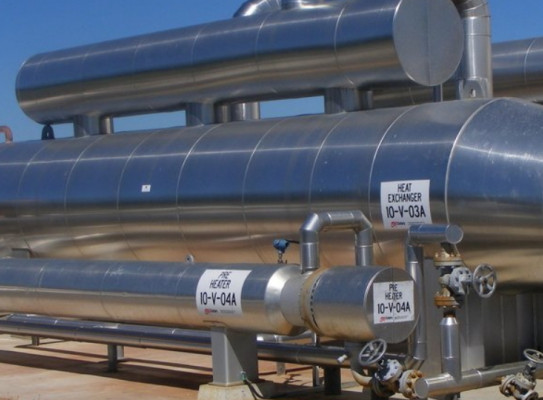
New Zealand’s Geothermal Future

This research programme provides a geoscience-based, multidisciplinary approach to refine our understanding of Aotearoa New Zealand’s geothermal resources.
Overview
Geothermal energy is a natural, abundant and renewable energy source.
New Zealand’s geothermal future's objective is to stimulate sustainable use of geothermal resources to provide for New Zealand’s clean, green, carbon-neutral energy future. It aims to maximise utilisation of geothermal resources for energy and heating while ensuring the protection (Kaitiakitanga) of New Zealand’s natural environment.
This programme is designed to provide scientific contributions in fundamental and applied geothermal research by using geophysical investigations, geological reconstruction, surface and deep fluid chemistry, reservoir numerical modelling, social science and Mātauranga Māori.
This programme aims to
- increase the utilisation and sustainability of low-temperature, near-surface geothermal energy to lower carbon emissions
- develop new models of the Taupō Volcanic Zone (TVZ) to better understand high-temperature (>160°C) geothermal resources
- understand natural emissions from geothermal fields and their environmental impact, and investigate methods for management
- understand and quantify Aotearoa New Zealand’s potential for direct geothermal heat use
The programme
The research programme is split into three projects:
Geothermal | Key to the Carbon Neutral Future – Geothermal is a critical source of renewable energy for New Zealand. The question is, can geothermal energy be carbon neutral? To answer this, GNS scientists are developing techniques that prevent CO2 emissions from geothermal power plants. transcript
Geothermal, key to the carbon neutral future.
Why is geothermal the key to a carbon neutral future?
Geothermal is a natural energy source that can be used to generate electricity. Geothermal systems are found in areas where there are lots of volcanoes.
In Aotearoa, New Zealand, most geothermal fields are found in the Taupō volcanic zone in the central North Island.
In this volcanic zone, CO2 is emitted naturally, let's look at this process.
Magma in the earth's crust heats water held in natural reservoirs. As the water heats, CO2 from the magma dissolves into the water.
When hot water rises, CO2 is released from the water.
Gas then escapes through hot pools, natural vents called fumaroles, or steam that escapes through the soil.
Gas that includes CO2.
So how can geothermal energy be carbon neutral? Let's examine how geothermal power plants work.
Water and steam are piped up from the geothermal reservoir under the ground.
Steam rotates the turbines.
A generator produces electricity, and then the water is injected back into the reservoir. This helps maintain pressure in the system.
When the water turns into steam, so do the gases, and at a geothermal power plant, even though the water is re-injected into the system, it may not include all the CO2. Some CO2 is released into the atmosphere. Scientists in the geothermal industry, including at GNS science are developing techniques to stop these gases escaping. It involves re-dissolving the CO2 in water then re-injecting it back into the reservoir.
Doing this helps maintain the geothermal system, while keeping the CO2 underground where it can't damage the environment.
Geothermal scientists are working towards a carbon neutral future.
Geothermal energy will give New Zealand energy security and help New Zealand reach its goals of 100% renewable energy, and net zero carbon emissions by 2050.
Geothermal | Key to the Carbon Neutral Future
Geothermal is a critical source of renewable energy for New Zealand. The question is, can geothermal energy be carbon neutral? To answer this, GNS scientists are developing techniques that prevent CO2 emissions from geothermal power plants.
Characterising New Zealand’s low enthalpy geothermal resources
Project leader: Dr Anya Seward
Low enthalpy geothermal resources can provide energy for direct heat for industrial and domestic scale industries, as well as potentially provide energy for small scale power generation. These resources are currently under-utilised and poorly characterised. However, they could provide a key alternative energy source to fossil fuels for several industries.
This project investigates key research questions of where, what and how low enthalpy and near-surface geothermal resources can be found and utilised. Projects include research into heat flow, thermal rock properties, subsurface temperature mapping, and the potential for sustainable use of these low temperature resources. The key objective is to increase the country’s utilisation of low-temperature and near-surface geothermal and promote efficient and sustainable use to lower carbon emissions.
Projects include
- Thermal rock properties investigations of typical New Zealand geological units, investigations into how thermal properties vary in different states of alteration, implications for heat transfer in differing subsurface environments
- Heat flow mapping. Investigations into areas of high heat flow, implications on subsurface temperatures, resources and potential for use
- Modelling non-conventional geothermal systems. Developing models of low-temperature geothermal resources.
- Geothermal use and strategy development. Advise on direct use and uptake of direct geothermal heat technologies. Create education and information documents on geothermal heat.
- Investigate cultural and economic significance of geothermal areas.

Understanding high enthalpy geothermal resources
Project leader: TBD
Geothermal resources represent a major energy source for New Zealand. The sustainability and potential increase utilisation of the high enthalpy resources is a government priority in order to achieve a low carbon future and the use of 100% renewable source of energy.
This project addresses the major research question of how heat, fluids and rocks interact over time within high-enthalpy geothermal reservoirs. Using a multidisciplinary approach, including experimental geochemistry, it explores the processes at depth that drive geothermal fluids toward the surface in particular the geological and geochemical constraints such as basement terranes and volcanic stratigraphy, as well as explore the chemical behaviour of subsurface geothermal fluid flow (including tracers) from medium temperature to supercritical in the subsurface and in plant infrastructure. We also investigate the longevity and location and future deep resources of the hydrothermal systems and their link with magmatism and tectonic at depth.
Projects include
- Large scale considerations of high enthalpy geothermal evolution within the Taupō Volcanic Zone
- Advancing modelling techniques to provide robust 3D models of productive geothermal reservoirs
- Investigate volcanic stratigraphy to understand the heat source and longevity of geothermal systems
- Investigations into effects of temperature, pressure and chemistry of geothermal fluids on geothermal extraction procedures for electricity generation
Understanding, managing and monitoring environmental impact
Project leader: Isabelle Chambefort
The sustainability and potential increase utilisation of the high enthalpy resources is key to achieve a low carbon future. Geothermal electricity generation in New Zealand is however not without emission. It became an industry priority worldwide to make electricity generation using geothermal as carbon neutral as possible without impacting the generation potential and natural environment. The project investigates methods to limit environmental impact, enhance sustainability, and reduce emissions from developed geothermal systems.
Projects include
- Assessments of heat loss from developed and non-developed geothermal systems
- Advancing techniques to determine near-surface permeability and fluid pathways in geothermal areas
- Characterisation of changes in geothermal reservoirs
- Understanding non-condensable emissions from developed and non-developed fields

Geological cross section between Ngatamariki (left) and Rotokawa (right) high temperature geothermal fields. Milicich et al. 2020(external link).

Research project details
Duration
2017–2024
Funding platform
SSIF
Status
Current
Programme leader
Dr Anya Seward, GNS Science
Funder
Ministry of Business, Innovation and Employment (MBIE)